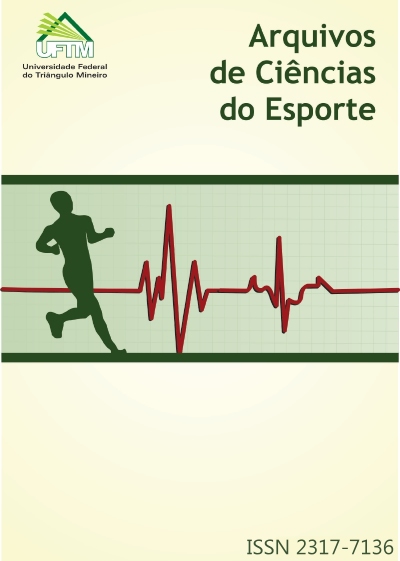Feasibility of using a continuous direct observation technique for assessment of free-living physical activity in young adults
Palavras-chave:
physical activity assessment, free-living conditions, criterion measureResumo
Objective: To demonstrate the feasibility and application of ‘continuous focal sampling’ direct observation (CFS DO) for physical activity (PA) measurement in free-living adults. Methods: Nine observers were trained to use CFS DO and completed two video-based examinations to evaluate observer reliability. We applied the method in free-living conditions by recording activity type and intensity among thirty college-aged students during 11.1 ± 1.0 hr observation periods. Results: Percent correct classification of activity type and intensity by the observers were 86.6 ± 6.5% and 76.1 ± 15.4%, respectively. Test-retest reliability coefficients for activity type and activity intensity were r = .79 and r = .78. Based on CFS DO measures, participants spent 57.4% and 15.5% of the time sitting and walking. Mean time spent in sedentary, light, moderate, and vigorous physical activity intensities were 359.6 ± 100.1, 178.8 ± 107.3, 85.4 ± 63.1, and 24.6 ± 24.6 min for the 11.1 ± 1.0 hr observation period. Conclusion: The CFS DO technique was reliable for assessment of free-living PA in the current study. Feasibility of CFS DO may be limited to shorter blocks of observation (2-3 hr).
Referências
Bonnefoy M, Normand S, Pachiaudi C, Lacour JR, Laville M, Kostka T. Simultaneous validation of ten physical activity questionnaires in older men: a doubly labeled water study. J Am Geriatr Soc. 2001 Jan;49(1):28–35.
Ekelund U, Yngve A, Westerterp K, Sjöström M. Energy expenditure assessed by heart rate and doubly labeled water in young athletes. Med Sci Sports Exerc. 2002 Aug;34(8):1360–6.
Plasqui G, Westerterp KR. Physical activity assessment with accelerometers: an evaluation against doubly labeled water. Obesity (Silver Spring). 2007 Oct;15(10):2371–9.
Brown WH, Pfeiffer KA, Mclver KL, Dowda M, Almeida MJCA, Pate RR. Assessing preschool children’s physical activity: the Observational System for Recording Physical Activity in children-preschool version. Res Q Exerc Sport. 2006 Jun;77(2):167–76.
Heath EM, Coleman KJ, Lensegrav TL, Fallon JA. Using momentary time sampling to estimate minutes of physical activity in physical education: validation of scores for the system for observing fitness instruction time. Res Q Exerc Sport. 2006 Mar;77(1):142–6.
Klesges RC, Coates TJ, Moldenhauer-Klesges LM, Holzer B, Gustavson J, Barnes J. The FATS: An observational system for assessing physical activity in children and associated parent behavior. Behavioral Assessment. 1984;6(4):333–45.
McKenzie TL, Sallis JF, Nader PR. SOFIT: System for Observing Fitness Instruction Time. J Teach Phys Educ. 1991 Jan 10;11(2):195–205.
O’Hara NM, Baranowski T, Simons-Morton BG, Wilson BS, Parcel G. Validity of the observation of children’s physical activity. Res Q Exerc Sport. 1989 Mar;60(1):42–7.
Puhl J, Greaves K, Hoyt M, Baranowski T. Children’s Activity Rating Scale (CARS): description and calibration. Res Q Exerc Sport. 1990 Mar;61(1):26–36.
Sit CHP, Lam JWK, McKenzie TL. Direct observation of children’s preferences and activity levels during interactive and online electronic games. J Phys Act Health. 2010 Jul;7(4):484–9.
Keating XD, Kulinna PH, Silverman S. Measuring Teaching Behaviors, Lesson Context, and Physical Activity in School Physical Education Programs: Comparing the SOFIT and the C-SOFIT Instruments. Measurement in Physical Education and Exercise Science. 1999;3(4):207–20.
McKenzie TL, Marshall SJ, Sallis JF, Conway TL. Leisure-time physical activity in school environments: an observational study using SOPLAY. Prev Med. 2000 Jan;30(1):70–7.
Altmann J. Observational Study of Behavior: Sampling Methods. Behaviour. 1974;49(3-4):227–66.
Powell J, Martindale A, Kulp S. An evaluation of time-sample measures of behavior. J Appl Behav Anal. 1975;8(4):463–9.
Tacha TC, Vohs PA, Iverson GC. A Comparison of Interval and Continuous Sampling Methods for Behavioral Observations. Journal of Field Ornithology. 1985 Jul 1;56(3):258–64.
Lyden K, Petruski N, Mix S, Staudenmayer J, Freedson PS. Validation of direct observation for estimating physical activity and sedentary behavior in a free-living setting. J Phys Act Health. 2012;In press.
Vanhees L, Lefevre J, Philippaerts R, Martens M, Huygens W, Troosters T, et al. How to assess physical activity? How to assess physical fitness? European Journal of Cardiovascular Prevention & Rehabilitation. 2005 Apr 1;12(2):102–14.
Ainsworth BE, Haskell WL, Whitt MC, Irwin ML, Swartz AM, Strath SJ, et al. Compendium of physical activities: an update of activity codes and MET intensities. Med Sci Sports Exerc. 2000 Sep;32(9 Suppl):S498–504.
Bonomi AG, Goris AHC, Yin B, Westerterp KR. Detection of type, duration, and intensity of physical activity using an accelerometer. Med Sci Sports Exerc. 2009 Sep;41(9):1770–7.
Freedson PS, Lyden K, Kozey-Keadle S, Staudenmayer J. Evaluation of artificial neural network algorithms for predicting METs and activity type from accelerometer data: validation on an independent sample. J Appl Physiol. 2011 Dec;111(6):1804–12.
John D, Liu S, Sasaki JE, Howe CA, Staudenmayer J, Gao RX, et al. Calibrating a novel multi-sensor physical activity measurement system. Physiol Meas. 2011 Sep;32(9):1473–89.
Staudenmayer J, Pober D, Crouter S, Bassett D, Freedson P. An artificial neural network to estimate physical activity energy expenditure and identify physical activity type from an accelerometer. J Appl Physiol. 2009 Oct;107(4):1300–7.
Bassett DR Jr, Rowlands A, Trost SG. Calibration and validation of wearable monitors. Med Sci Sports Exerc. 2012 Jan;44(1 Suppl 1):S32–8.
Strath SJ, Bassett DR Jr, Swartz AM. Comparison of MTI accelerometer cut-points for predicting time spent in physical activity. Int J Sports Med. 2003 May;24(4):298–303.
Kozey-Keadle S, Libertine A, Lyden K, Staudenmayer J, Freedson PS. Validation of wearable monitors for assessing sedentary behavior. Med Sci Sports Exerc. 2011 Aug;43(8):1561–7.
Troiano RP, Berrigan D, Dodd KW, Mâsse LC, Tilert T, McDowell M. Physical activity in the United States measured by accelerometer. Med Sci Sports Exerc. 2008 Jan;40(1):181–8.
Downloads
Publicado
Edição
Seção
Licença
Deverá ser encaminhado, no momento da submissão, em documentos suplementares, as declarações de transferência de direitos autorais, responsabilidade e conflito de interesse. As declarações deverão ser elaboradas em documento único, conforme modelo disponibilizado aqui, e assinada pelo autor principal do manuscrito representando cada um dos autores.


